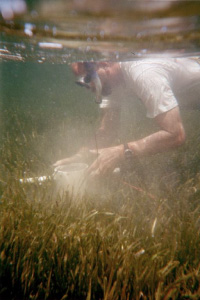Dr. Michael Kemp's career at the University of Maryland started with seagrasses. (The term "seagrass" means all
the "higher" (not algae) plants that grow beneath the water's surface rooted in sediments.) He had made the
decision to study coastal waters in grad school, preferring something that he could dive down and see them alive
in their own habitat.
When he arrived at the University of Maryland, EPA's Chesapeake Bay Program was just beginning to take shape.
In 1978, as post-docs, he and his colleague Walter Boynton wrote a large proposal. "One of the big questions was,
what's killing the seagrass in the Chesapeake?," says Walter. "We were interested in what the seagrass communities
did in the Bay ecology, and in social and economic implications. He and I started with an effort looking at
underwater grasses and their growth requirements, for example, how much light did they need?"
The two young scientist developed the vision to write a large project description and to have the topics connected
to human behavior. "In the end we got funded and that set my career in motion," says Michael today.
"I liked the idea of being able to see what I was studying." |
"Our work in that original project demonstrated unequivocally that the seagrasses were being lost because we were
polluting with nutrients in the bay," he says. "Nutrient pollution was accelerating growth of algae both in the
water and on the leaves of the plants. The plants were just suffocating; they couldn't get enough light to
photosynthesize. Now it seems obvious." The work of Michael and his colleagues was instrumental in getting a
program for seagrass restoration started. While Congress was allocating money to coastal management for submerged
plant restoration, Michael's view was oriented toward doing more research on how to improve the environmental
conditions. "We had a difference of opinion about that but in the end we've come to an agreement," says Michael.
"The scientific community helped lead the managers to a more sensible strategy for restoration."
"It went from being a great idea and a science challenge to now being part of how we define water quality standards
for the Chesapeake," says Walter Boynton. "That's the water quality condition promised to the public by the Clean
Water Act. If you don't have seagrass, you don't have a Chesapeake Bay ecosystem."



